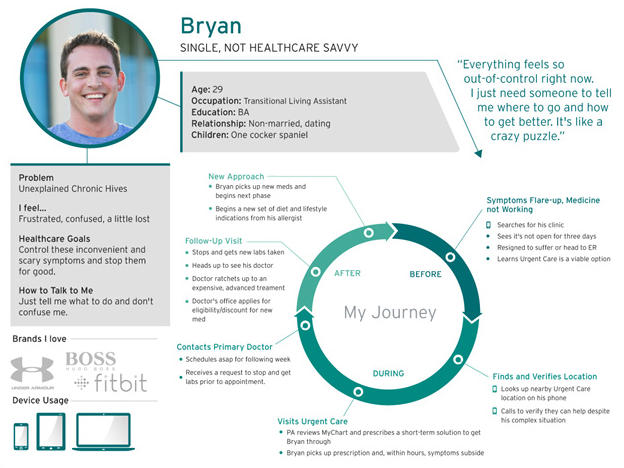In this blog series, we explore experience design for the patient and member journey.
Strategy to Improve Digital Experiences in Healthcare
Healthcare Journeys: Understand Barriers, Disconnects, and Alternate Paths
The fundamental place to begin is with a deep and empathic understanding of your audience, their journeys, emotional context, and the specific and logical paths they will likely seek. Map it out and consider the step-by-step needs and considerations. Put yourself in the shoes of someone who does not possess your institutional or organizational knowledge.
In a previous blog, we explored the example of Bryan’s patient journey. He’s in a tough spot as it is with his health situation.
Chronic urticaria is often a great mystery and requires months, even years, of trial and error and new treatments. And he will be prone to those unexpected, sometimes scary, flare-ups during his foundational treatment plan. But, in the story we shared, no one was prepared to help him.
It’s easy for marketing teams to think “we know what our patients want.” But that point of view is invariably focused on an acquisition marketing model – which isn’t bad – but it’s incomplete.
We recommend a mix of activities to help you discover, validate, and verify consumer perspectives:
- User surveys
- Focus groups
- Contextual interviews
- Patient/member advocacy groups
- Build personas

Healthcare Persona Card
Personas are hypothetical users you can put a face on. They represent a set of attributes that sound and feel like real people. Personas can assume any number of formats and the data can vary. The value is the process – validating information as a team, hopefully with real data and real patient or member input.
Ultimately, personas should help you understand where consumers are coming from, how to talk to them, and their common touchpoints.

One of our clients created life-size personas they carry with them to meetings for a visual reminder
With personas, we can perform “what if” thought and mapping experiments so we’re not making decisions in isolation or from an insular perspective. You can make your personas regular characters in all work you do. Instead of starting with tactics, take time to step back and think about your user.
RELATED: Your Guide to Healthcare Personas
Then run through the journey to make sure you’ve considered any potential barriers, disconnects, or alternate paths you can help support.
NEXT: Tips to Map Healthcare Audiences: Scenarios and Journeys

